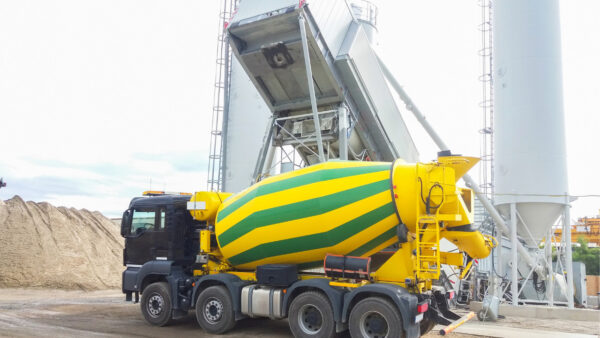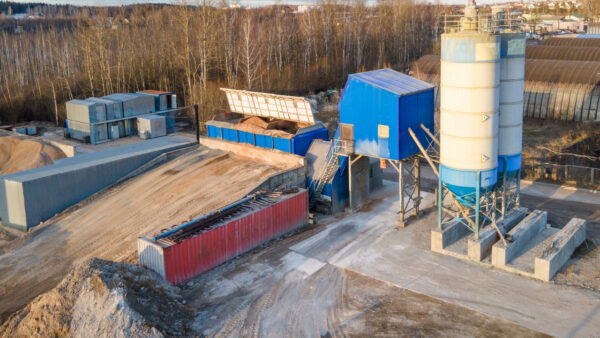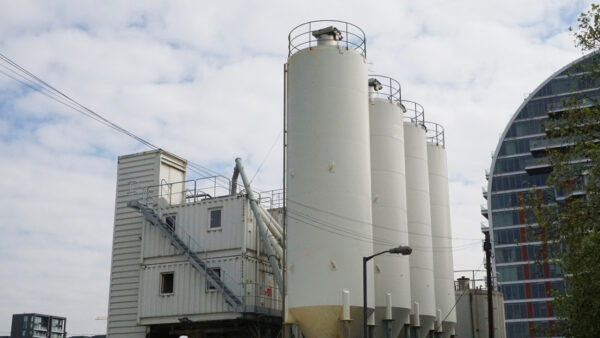Concrete is considered to be a versatile choice for construction activities. It not only provides the promised strength but also durability to a structure with its raw materials easily available and accessible.
Time and again researchers have tried to modify and enhance the properties of concrete to suit their needs and the road to advancement has proved a never-ending trek. Advanced concrete types are now in common and have brought to light promising results. One such advanced concrete type is ready mix concrete.
Ready mix concrete (RMC) is a type of advanced concrete that is manufactured off-site i.e., in large batching plants based on the standard, engineered mix design. The ingredients are batched or proportioned on a standard practice, mixed and transported to site on large truck or transit mixers.
The transit mixer is of two types. In the first type, the concrete ingredients are only dry mixed at the batching plant, loaded into the agitator truck mixers with water added during the transportation to site.
In the second type of transit mixers, the concrete is prepared in the wet state at the batching plant and is transported to the site through truck mixers.
During transportation to site, the drum is made to rotate continuously till the concrete is placed. This is to keep concrete in a plastic and workable state until is transferred to mold for hardening.
Table of Contents
Conventional Concrete Mixing vs RMC Mixing
Conventionally, the mixing of concrete ingredients is done on site either manually or mechanically using small mixers. However, this mixing technique is only used for small projects like a house construction. Contrarily, ready mix concrete is used for large projects such as high-rise buildings, bridges, roads, etc.
In case of conventional mixing, the required level of consistency is hard to obtain because of a number of parameters that physically cannot be governed. However, when mixing becomes automated as in central batching plants, the desired workability of concrete can be achieved and its properties can be tailored as per design.
Concrete that is mixed and prepared on site often requires storage space for the ingredients such as coarse aggregates, fine aggregates, etc. This problem of storage is practically offset when you go for ready mix concrete.
The monitoring of concrete while mixing is a crucial task when performed on-site in small mixers and chances of human error are greater. On the other hand, RMC production requires less labor and the Cube Test Report can help monitor the concrete properties easily.
It is often observed that with conventional mixing, the target compressive strength is hard to achieve. For instance, if you are targeting 2500 psi compressive strength and you go for on-site mixing in portable mixers, you will probably end up with a reduced strength. Therefore, a safety margin should be kept if quality control is hard to achieve.
Conventional concrete requires more labor to perform on-site activities including conveying ingredients from one place to another and into the mixer, manually mixing concrete, etc. However, RMC requires less labor but they must be skilled at their job.
With manual mixing, only the nominal concrete mix can be prepared with strength less that 20MPa but with RMC, you can get nominal as well as design concrete mixes.
It might seem by now that ready mix concrete should replace all concreting works around the world and the construction industry should switch to this method of concrete production permanently. However, what makes conventional concrete mixing a viable option for your projects is its cost.
Site mix is often cost effective in comparison to ready-mix concrete and this is where the choice of which type of mixing should be used depends largely on the project type and the allocated budget.
Why is RMC Preferred for Large Concreting Works?
The answer to this question is “quality control”. Using RMC, you will not end up with concrete batches showing marked disparities. Instead, owing to computerized proportioning of ingredients, adequate quality control can be exercised and the mixing process can also be regulated.
In case of concrete mixing at site, maintaining quality control and producing adequately similar concrete batches becomes a challenge. Therefore, the production of RMC at one centralized location can help offset this problem.
Manufacturing Process
The central batching plant comprises the following main parts that perform their due functions in a systematic manner.
- Cement Silo
- Twin Shaft Concrete Mixer
- Water Weight System
- Cement Weight System
- Admixtures Weight System
- Cement Screw Conveyor
- Aggregate Belt Conveyor
- Aggregate Batching System
- Intermediate Storage Tank
The coarse aggregates (of variable sizes e.g., 10mm down, 20mm down, etc.) present in hoppers of aggregate batching system and are weight-batched on a conveyor belt or skip bucket weighing belt. The aggregates are then shifted to the mixer via an inclined conveyor belt.
The fine aggregates are also present adjunct to the coarse ones in hopper and their required weight is shifted to the conveyor belt and finally into the concrete mixer.
Cement and other cementitious materials (fly ash, bagasse ash, etc.) stored in silos are batched and conveyed to the mixer through a separate cement screw conveyor.
The concrete mixer is attached with an admixture weight system and water weight system (water tank) that add admixture (if any) and the desired water quantity once the dry ingredients are fed into it.
The mixed concrete is then loaded into the drum of the truck or transit mixer and transported to the construction site with mixer being agitated along the route.

Ready-mix concrete being poured into the formwork
4 Ways to Handle Concrete from Central Batching Plants
The concrete batched at the central batching plant can be handled and mixed in different ways. However, all these are types of ready-mix concrete. These are explained as follows.
-
Central-mixed concrete
This type of concrete mix is completely mixed at the central batching plant and the trucks only act as the mode of transporting concrete to the site with slight agitation during conveyance.
The slight agitation of mix during transportation helps reduce the slump of concrete that may occur is the concrete is left still for a long time. The truck can also be used to remix the concrete at the construction site, if required.
-
Truck-mixed concrete

Truck mixer carrying RMC
Truck-mixed concrete is completely mixed in the truck or mobile mixer on the way to the construction site. The dry mix of concrete is charged in the truck and during transportation when you are about to reach the site, water can be added in the drum which is then made to rotate at a controlled rotation speed.
The advantage of this type of mixing is that the dry ingredients can be kept segregated and just when you are close to the job site, you may add the measured water quantity and shake up the mix to place and compact it timely.
In this case, problems of delays in transportation or placement can be avoided. However, it is important to ensure that the aggregates used are surface dry, otherwise the hydration of cement will commence to some extent as the cement comes in contact with the wet aggregates.
The amount of concrete that can be transported in a truck mixer depends on the method of mixing. To provide proper agitation to the mix, the volume of central-mixed concrete is limited to 80% of the total volume of the truck mixer. For all other methods of batching, the concrete quantity in the drum is limited to 63% of the drum volume since the drum has to serve a twofold purpose, agitation and mixing.
-
Transit-mixed concrete

Transit RMC Mixer
This type of concrete is partially or completely mixed during conveyance to the job site.
-
Shrink-mixed concrete
This type of concrete mix is partially mixed at the central plant to shrink or reduce the overall volume and later, the mixing is completed in the truck mixer.
ASTM’s Regulation for Concrete Placement
The American Standard for Testing and Materials (ASTM) C-94 requires that the concrete should be placed within 1.5 hours of mixing or before the drum has passed through 300 revolutions.
However, the code has waived off these limits on part of the purchaser if the concrete is workable enough to be placed without adding water to the batch.
Remixing of RMC
When ready mix concrete is used for a construction work, it is transported from the batching plant to the site during which alteration in slump may occur. Therefore, when the concrete is transported to site, it is often remixed just before placing to ensure that the correct slump is achieved.
If this is the case, the earlier mixing period should be kept such that at least half the minimum mixing time is accorded to the remixing period and that the total number of revolutions does not exceed specifications.
Applications of Ready-Mix Concrete
In concrete construction works (be it plain concrete or reinforced concrete), wherever the strength required is in excess of 20MPa, you can go for ready-mix concrete given that the project’s allocated budget allows you to do so.
Some examples of construction works where RMC an effectively be used are given as follows.
- Construction of bridge components (deck slab, girders, piers, etc.)
- Runways and other concrete pavements
- Tunnel lining
- Concrete dams and other hydraulic structures
Cost of Ready Mixed Concrete (RMC)
Firstly, the cost of any type of concrete has a direct bearing on its mix design ratio (i.e., the proportion of components to be used in the concrete mix).
In addition, the type of project (sidewalk, driveway, bridge deck, etc.) also controls the cost of concrete. The quantity of concrete is typically measured in cubic yards and the rates fluctuate depending on the area the batching plant is installed and the commuting distance to the delivery site.
As a general guideline, the costs incurred in a ready-mixed concrete batch when compared to that of a site-mixed batch are 20 to 30 percent more. Given this, for small projects, going for RMC is not an economically justified or even viable option. However, when large quantity of concrete is to be manufactured, RMC will not only provide you quality but also lessen the work time of your project.
Advantages of Ready Mixed Concrete
- Owing to a systematic and programmed delivery of concrete at site, the construction work can be speeded up and unwanted halts can be avoided.
- Using ready mixed concrete (RMC), you will have reduced labor cost and site supervising cost.
- The computerized control over the proportion of concrete ingredients as per mix designs (coarse aggregates, fine aggregates, cement, and water) at the batching plant ensure quality control and consistency in concrete production.
- The usage of RMC also helps reduce the wastage of raw materials during storage at the site.
- Ready mix concrete is prepared using lesser cement and this can help conserve energy and resources. Therefore, RMC can prove to be an environmental-friendly approach of using concrete for development projects.
- The dependency on human labor is reduced since everything is essentially done in an automated manner in batching plants. This can help reduce the overall project’s labor cost and material saving can also be done.
- With quality control of concrete comes durability and sustainability. The concrete ingredients proportioned by weight help produce good quality hardened concrete with lesser number of voids and a sound internal structure.
Disadvantages of Ready Mixed Concrete
- RMC requires special formwork arrangements since the movement of concrete through pumps can induce vibrations.
- If the transit mixer is not of a good quality, there is a possibility of loss of concrete quality on its way to the construction site.
- A proper conveyance or transportation system is a must for timely delivery of concrete from batching plant to the construction site.
- Ready-mix concrete is not suitable for small concreting works (where lesser amount of concrete is required).
- The initial investment that you will be needing for the preparation and delivery of ready-mix concrete amounts to a great sum. Therefore, despite its benefits cumulating in your mind, the cost-effectiveness of RMC is surely a no-no for small projects.
- The concrete that is mixed in the central batching plants has lesser time for handling and is to be placed within the limited time otherwise, its workability and other plastic-state properties may alter to an extent that the change becomes irreversible. In such a pesky situation, traffic jams and other obstructions along the route may even lead to concrete hardening inside the mixer, incurring monetary loss and a delayed construction work.
Frequently Asked Questions (FAQs)
What is the difference between nominal mix and design mix?
Nominal concrete mix is only used for small concreting works that do not requires a high compressive strength. Generally, with the nominal concrete mix, you will end up with a compressive strength of less than 20MPa (M20 Grade).
For higher strengths (above M20 grade) and important concreting works, the design mix is used. This type of mix assertively guarantees the quality control, strength, workability and durability of concrete and possible deviations in results can be reduced.
Is ready-mix concrete cheaper than conventional site-mixed concrete?
If the cumulative cost of concrete per batch is compared, RMC is expensive in comparison to the conventional concrete mix. This is owing to enhanced quality control, systematic operation and high initial investment requisite for RMC production.
Can admixtures be added in ready-mixed concrete?
The central batching plant where the ingredients are proportioned and added into the mixer also comprises an admixture weighing system. The purpose is to include a measured quantity of admixture into the mixer as per requirement.
This means that even with ready-mixed concrete, you can tailor the properties as per your design to get a mix of desired properties.








